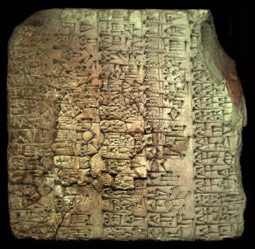About cuneiform: its development, uses, and modern representation
Cuneiform is a lot more complicated than modern alphabets. It uses hundreds of signs, in many different ways, and the appearance and meanings of those signs changed significantly over the 3000 years of its history. There are now standard ways of representing cuneiform alphabetically, in print and on screen. Use the links below or in the menu to the left to select an article and learn more.

Trainee scribes learned cuneiform by copying out and memorising long, standardised lists of sign, words, and phrases. This list of words in Sumerian cuneiform was written in the city of Šurrupak (modern Fara) in about 2500 BC (VAT 12777). © Vorderasiatisches Museum Berlin. View large image on the Cuneiform Digital Library Initiative website.
Introduction: Cuneiform. How 'cuneiform' writing developed from pictographic writing. Sumerian and Akkadian. Chronology. Development of the cuneiform writing system.
Wedges and signs: Wedges. How signs are formed of several strokes. Complex signs. Direction of writing. Conventional order of signs.
Categories of signs: Syllables (V, CV, VC, CVC, CVCV). Logograms. Determinatives. Phonetic complements. Polyphony of signs. Heterography of syllables.
Phonology: How the phonology of Akkadian is expressed in cuneiform writing. Long vowels, doubled consonants; glottal stop; diphthongs; glides. Ambiguities.
Neighbouring and related scripts: Other languages which adapted cuneiform. Other types of cuneiform. Other scripts used in Mesopotamia.
Transliteration: How to 'read' signs. Correct transliteration. Use of logograms, phonetic complements, glosses. Use of determinatives in Akkadian. Numerical and metrological signs. Editorial marks.
Computer cuneiform: Common conventions in ASCII. Unicode for transliteration and cuneiform. ATF as a disciplinary standard. Online corpora of cuneiform texts.
Content last modified on 10 Jan 2017.